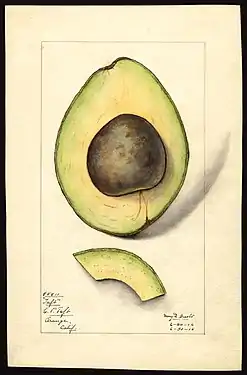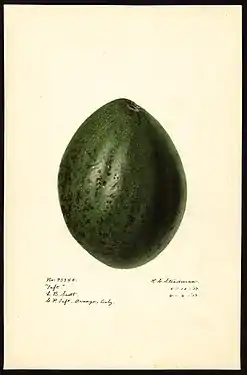Lula (avocado)
The 'Lula' avocado (Persea americana 'Lula') is an avocado cultivar that originated in south Florida.
| Avocado 'Lula' | |
|---|---|
| Genus | Persea |
| Species | P. americana |
| Cultivar | 'Lula' |
| Origin | Florida |
'Lula' became a widely propagated avocado after its introduction due to favorable characteristics, including its eating qualities.
History
The original tree reportedly grew from a 'Taft' avocado seed – named after Charles Parkman Taft (1856–1934) – planted in 1915 on the property of nurseryman George B. Cellon in Miami, Florida, and was named after Cellon's wife, Lula Cellon.[1] DNA analysis has indicated 'Lula' was likely the result of a cross between Guatemalan and Mexican type avocados. The tree first fruited in 1919 and was recognized for its excellent eating qualities. Propagation of 'Lula' began in 1921.[2]
'Lula' became recognized for its excellent eating qualities, steady production, and cold hardiness. It did have a drawback however in that the fruit was susceptible to scab. 'Lula' was widely propagated both for the commercial trade and home growing. It continues to be sold on a large scale despite the availability of newer cultivars, and it is often used as a rootstock for grafted avocado trees.
'Lula' trees are planted in the collections of the USDA's germplasm repository in Miami, Florida.[3][4]
Description
'Lula' fruit has a glossy green skin and is pear-shaped. The flesh has high oil content, around 12-16%. The fruit matures from October to February in Florida.[5] 'Lula' produces A-type flowers.
Gallery: Taft avocado
References
- Dorn, Harold W. (1956). "Mango Growing Around Early Miami" (PDF). Tequesta. Historical Association of Southern Florida: 47.
- "Variety Database Search Results for ..." avocadosource.com. Retrieved 28 November 2012.
- "MIA 7828 : Persea americana Mill. LAURACEAE (avocado)". Germplasm Resources Information Network (GRIN). National Germplasm Resources Laboratory, Beltsville, Maryland. Retrieved 28 November 2012.
- "MIA 36136 : Persea americana Mill. LAURACEAE (avocado)". Germplasm Resources Information Network (GRIN). National Germplasm Resources Laboratory, Beltsville, Maryland. Retrieved 28 November 2012.
- Crane, Jonthan H.; Balerdi, Carlos F.; Maguire, Ian (December 2010). "Table 2. Some characteristics of Florida avocado varieties recommended for the home landscape". Circular 1034: Avocado Growing in the Florida Home Landscape. Horticultural Sciences Department, Florida Cooperative Extension Service, Institute of Food and Agricultural Sciences, University of Florida.





